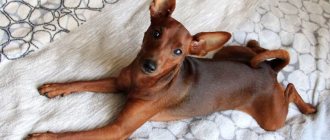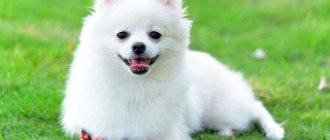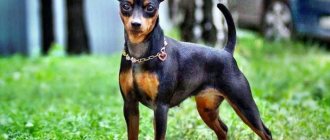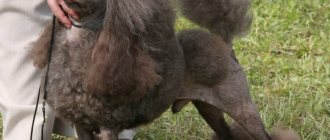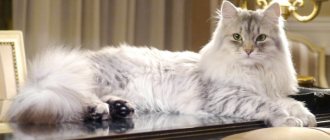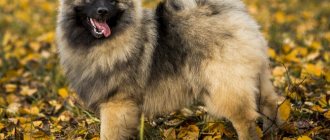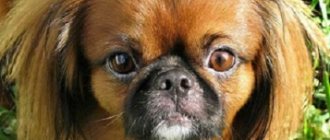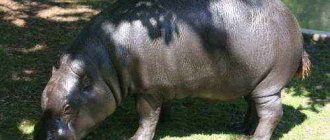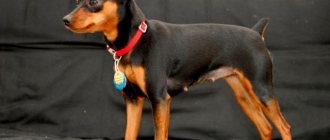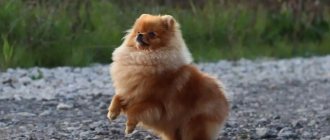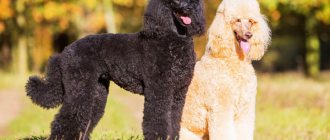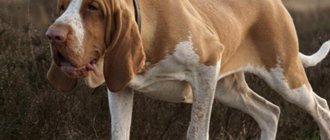Description of the Miniature Schnauzer breed
Popularity 90th place among 263 dog breeds
Lifespan:
12-15 years
Breed group:
Service
Height:
30-35 cm
Country of origin:
Germany
Average price:
25-35 thousand rubles
Weight:
4-8 kg
Latest articles Cat health
Ataxia in cats: what is it, how does it manifest and is treated 01/23/2022 156 0 0
Cat health
Leukemia, or viral leukemia in cats 01/23/2022 145 0 0
FCI standard
Table 1. Miniature Schnauzer: breed standard
| Parameter | Description |
| Head | Oval, slightly extended forward. The forehead is not protruding, there are no wrinkles |
| Eyes | Small, oval-shaped, dark in color, do not mow. Tight eyelids |
| Ears | Soft. According to the standard, they are docked and stand in a triangle |
| Neck | Powerful, not elongated |
| Breast | Medium width, oval. It bends at the bottom |
| Front legs | Straight, have a small distance between each other. The collarbone is straight on all sides. The shoulder blade is oblique and moves back. The shoulder is athletic. The angle of contact with the blade is 95/105 degrees. |
| Hind legs | When viewed from the side, they are mowed, from behind - they are not narrowly located, synchronous. The thigh is wide and of medium length. The knee is not twisted and does not go inward. The position of the limbs is “at the start”. The lower leg is powerful and strong |
| Wool | Wire-like, dense, similar undercoat |
| Color | Black/dark gray with tan/white/black with silver marks. Let's say ash and silver with off-white. A dark mask is required in all colors |
| Weight | Around 6 kg |
| Height | Does not exceed 35 cm |
A dark mask is mandatory for every Miniature Schnauzer.
Culling
Any deviation from the following points shall indicate a deficiency. Among the special ones are:
- The head is oval shaped;
- The presence of folds in the forehead area;
- Sharp muzzle, shortened;
- Straight bite;
- Extending cheek bones;
- Ears that are not parallel;
- Light, large/small eyes;
- Suspender/folds in the throat area;
- Back with a hump;
- The upper part of the neck is narrow;
- Beveled back;
- Tail like a hare's;
- Excessively long limbs;
- Soft wool with curls;
- Chocolate-colored undercoat;
- Black saddle;
- Color “black and silver” - the markings on the chest are not separated;
- The height at the withers deviates from the norm by more than 10 mm.
Severe defects include short legs and loose build. Also considered a defect is a “bitch in male type”, twisted elbows or hind legs. An elongated shin and short metatarsals are also the basis for such a mark.
Important! If the height at the withers exceeds 20 mm above normal, this is considered a significant deviation.
Cowardice and suspicion are considered vices on a par with flaws in appearance
Disqualifying defects include deformities of any kind, lack of breed, improper bite and anything related to the jaw. They also look at cowardice, aggression, and malice. Attention is drawn to the dog's irritability and excessive suspicion.
Key facts
The Miniature Schnauzer translates from German as “barbel gnome,” or “whiskered face,” and the dog lives up to its name, being the smallest working breed in the world.
As a service dog, miniatures are used mainly by drug and explosives departments, in which the dogs are helped by their outstanding sense of smell and excellent intuition. The description of the Miniature Schnauzer breed states that the dogs, in addition to their service qualities, have well-developed hunting and guarding skills.
The miniature himself, despite his miniature size, is ready to loyally protect his family with all the seriousness of a large service dog. Or herd sheep - he can do that too.
The Miniature Schnauzer is an excellent companion, he loves children and will be a wonderful play partner for them. They are suitable for both apartment living and living in your own home.
Miniature Schnauzers are very active dogs and show good results in sports. The characteristics of the Miniature Schnauzer breed add to this that the dog requires a good walk.
Like any dog, especially a service dog, a miniature dog must be trained, socialized and educated.
Miniature Schnauzers are very healthy dogs; usually, diseases begin to appear only in old age. The life expectancy of a miniature schnauzer is very high. But in terms of care, this breed is quite labor-intensive. If you want to see your pet beautiful, you will have to regularly cut it, trim it or contact a professional groomer, especially if you have a show dog.
Miniatures have only four generally recognized colors: black, pepper and salt, black and silver and white. In some countries, dogs of unrecognized colors are bred.
The breed is one of the ten most popular in the world because of its easy-going, cheerful character even in old age, its willingness to keep company and take part in any adventures of its owner.
Cupping
The procedure of tail amputation and ear cropping has been considered controversial in the global canine community in recent decades. In a number of countries, docking of ears and tails is prohibited as such, which is why modern international standards gravitate towards the natural undocked appearance of animals. The same applies to miniature schnauzers. Their show appearance is with naturally shaped ears and a tail. But, as experienced dog breeders point out, in countries where docking is not prohibited, unscrupulous breeders can thus hide defects in the corresponding body parts of puppies.
History of the origin of the miniature schnauzer
The breed originated in Southern Germany. These dogs were used on the continent for the same purposes for which terriers were used in Great Britain - for home guarding and hunting rodents. Presumably, at that time they were pinschers, smooth-haired and wire-haired. In the middle of the 19th century, wire-haired dogs began to be separated into a separate branch. At that time there was no division into miniature, miniature and giant schnauzers; wire-haired individuals of all sizes were simply called rattlers, and later - schnauzers.
The record of the first schnauzer dates back to 1888. At an exhibition called “Wirehaired Pinscher”, it was first presented a year later by a male named “Schnauzer”, from where the breed took its name. Josef Bertha, chairman and founder of the Pinscher Club in 1895 in Saxony, made a great contribution to the development of miniatures. He began breeding work on breeding dwarf schnauzers and worked closely with the Saxon nursery Chemnitz-Plauen.
The goal was to breed a small companion who could live in small apartments and at the same time have all the working and personal qualities of a Schnauzer. The theory about the selection of the smallest schnauzer puppies for breeding miniatures has not been confirmed - most likely, the blood of Affenpinschers, poodles, and Spitzes was used to produce a miniature schnauzer. Sometimes these impurities produced undesirable colors, and multi-colored and white puppies were excluded from breeding.
Despite this, there is still a rich variety of unrecognized colors among miniatures. In 1902, 14 representatives of the breed were already registered in the stud book of the Pincher Schnauzer Club.
In the first half of the 20th century, schnauzers spread throughout the world. They came to the USSR only in 1974: these were three dogs imported by Grossman from the USA, but the main stock originates from service Czechoslovakian miniature dogs, donated by Czechoslovak servicemen to their colleagues in Lvov. From there, the little schnauzers came to Moscow with the permission of the USSR Ministry of Internal Affairs. These bloodlines can still be traced in many representatives of the breed. The National Breed Club (NKB) was created in Russia in 1994.
Nurseries
There are quite a lot of nurseries in Russia that practice breeding miniature schnauzers. They are in Moscow and the Moscow region, in St. Petersburg, in Kaluga, Saratov, Vyborg, Taganrog, Yuzhno-Sakhalinsk, Yekaterinburg, Saransk, Penza, Sevastopol, Nizhny Tagil, Kazan, Veliky Novgorod, Togliatti, Stavropol, Rostov-on-Don. Don, Krasnodar, Noginsk, Kaliningrad.
When purchasing a miniature schnauzer puppy, you need to remember the cunning and mistrust of this breed. But if you manage to win over your baby and make friends with him, you will hardly be able to find a more faithful and devoted friend. The miniature schnauzer has absorbed all the best qualities of representatives of dog breeds. It is not for nothing that it ranks seventh in popularity; the number of nurseries for breeding it speaks for itself.
*Prices are current as of December 2022.
Appearance of miniature schnauzers
General impression
The Miniature Schnauzer is a smaller copy of the Miniature Schnauzer without signs of dwarfism. This is a small, strong dog with a square body, cheerful and temperamental, with a stable psyche.
Head
The head is strong, slightly elongated, harmonious in relation to the body. There is practically no occipital protuberance, the bridge of the nose is straight and flat. There are no folds on the forehead. The transition from the forehead to the muzzle is quite pronounced and emphasized by shaggy eyebrows. The muzzle is wedge-shaped, blunt, ending in a black, well-defined nose.
Powerfully developed jaws are covered with tightly fitting lips. The dental formula is complete, white large teeth are closed in a scissor bite. The nodules are developed but do not change the shape of the muzzle.
The eyes are oval, dark brown, look with lively interest, the eyelids are not heavy and do not droop. The ears are set high, hanging behind the break line, have a triangular uniform shape and touch the edges of the cheeks.
Neck
The neck corresponds to the image of a dog: strong, with a clear scruff, smoothly ending at the withers. The skin fits tightly, there are no folds.
Torso
The body is square in shape, the line of the back is higher at the withers and smoothly descends to the croup. The back itself is strong with a short but deep loin, giving the dog a square shape. The chest is well developed, moderately wide, and when viewed in profile reaches the elbows. The belly is tucked up and forms a single bottom line.
Tail
The tail is saber-shaped or sickle-shaped, set high. It can stop in non-show dogs in the area of the third joint.
Forelegs
The forelimbs are strong with good angulations and pronounced shoulders. The elbows are pressed tightly to the body, the limbs themselves are parallel, not turned out. The paws are round, cat-like, with tightly knit toes.
Hind limbs
The hindquarters are well-muscled, sloping at the sides and parallel at the rear, with clear, good angulations, short metatarsals, perpendicular to the surface.
Movements
The movements are sweeping, elegant, well coordinated, with a strong reach of the front legs and an equally strong push from the hind legs.
Wool
The miniature's coat should be thick and hard, like wire, with a thick undercoat and a long, straight spine. Its toughness is noticeable even in the photo of a miniature schnauzer. American dogs have much softer fur than European dogs. Thick eyebrows and beard are clearly visible.
Color
Until 1976, there were two canonical colors of the miniature schnauzer - pure black, without a brown tint, and pepper and salt. In 1977, black and silver was recognized. The white color has had a long and thorny path - more than 35 years passed from the first white puppies to the recognition of the color in 1983.
White miniature schnauzers, contrary to popular belief, are not albino - they are a recessive red color produced by pepper-and-salt dogs. For a long time, chocolate and tan miniatures were bred; this color was especially popular in Russia, but in 2010, after a statement by the Pincher Schnauzer Club, this color was closed by the FCI, and after it in 2011 by the RKF, as not meeting the standard, t .To. Dogs of this color have a brown nose, lips, and light brown or green eyes.
Many enthusiasts in Russia are still breeding them outside the RKF system. Also in different countries, mainly in the USA, miniature dogs of exotic colors are bred as designer dogs. These include liver, chocolate, baked milk, red agouti, blue and liver merle, and just a variety of spotted colors.
Size
The dimensions of the miniature schnauzer are the same for males and females; they range from 30-35 cm in height and 4-8 kg in weight. The growth of a miniature schnauzer should not be too great, since miniature schnauzers already begin to grow beyond the limits.
The Miniature Schnauzer's weight does not need much control: thanks to its mobility, the dog is not prone to obesity. Despite the size of miniature schnauzers, dogs cannot be classified as decorative dogs - they are smart and brave animals with a big heart.
Possible disadvantages
In the description of a miniature schnauzer, the following are considered non-compliances with the standard:
- Round and massive skull;
- Folds on the body;
- Muzzle that is too short or excessively pointed and elongated;
- Elongated, curved back;
- Long, soft, wavy coat;
- Imperfect bite, yellow and sparse teeth, presence of caries;
The presence of pathological nervousness, suspicion, uncertainty and timidity, as well as excessive aggression.
Character of the miniature schnauzer
The character of the Miniature Schnauzer was inherited from its ancestor, the Miniature Schnauzer. A brave heart beats in a small miniature. Representatives of this breed are temperamental, vigilant, have a stable psyche and excellent watchdog qualities. Already a small puppy is ready to selflessly defend his home and family from strangers. Adult dogs very clearly distinguish between friends and strangers and are wary of strangers.
Miniature Schnauzers love children. Children for them are the best companions for games and pranks, in which miniatures are tireless. They get along well with other animals. The exception is the historical prey of miniature schnauzers - small rodents, which it hunts no worse than cats. If you have a miniature mouse in a house with mice, the latter will quickly disappear.
Miniatures are kept at home, even if they live in a country house. They are not suitable for outdoor use. Miniatures will feel great in an apartment.
Who is this breed suitable for? The zverg is a wonderful pet and is suitable for almost everyone: a single man, a noisy large family, and cheerful, active old people. You should not get a miniature dog if you are a homebody or a workaholic who disappears at work, or if you think that a small dog does not need training and education.
Miniature Schnauzers are charming in their cunning: they are rare sneakers who, at the same time, are wholeheartedly devoted to their owner and are ready to give their lives for him.
Is it hypoallergenic?
You can find information that Miniature Schnauzers belong to hypoallergenic breeds, such as the Downy Chinese Hairless, Maltese or Brussels Griffon. Is this true or not? Let's try to figure it out.
It's all about what you're allergic to . If the cause of the disease is falling out fur, then it does not fall off the Tswerg. However, you will have to contact it: combing, ironing and plucking. This means allergies, if any, cannot be avoided.
The second case is when the cause of the allergy is not fur, but dog saliva, dander or skin secretions. Here it is better to refrain from purchasing a dog of any breed for your home.
Education and training
Due to their nature, miniature schnauzers require full training, and training a dog should begin from the moment it appears in the house. The owner must become an authority for the puppy, otherwise achieving obedience will not be easy.
How to stop your baby from biting and chewing things? The most effective way is to take advantage of the breed’s temperament and playfully switch the puppy’s attention to balls, squeakers and toys. Miniatures are by nature more playful, so during training, games, praise and a favorite object will be an excellent reward for a correctly completed exercise.
Miniature Schnauzers are easy to train, intelligent and always ready to work. Exercises for miniatures should not be monotonous and monotonous. Despite their excellent working qualities, this breed is much easier to train through play.
Representatives of this breed have excellent visual memory, so it is imperative to reinforce voice commands with gestures. Thanks to this feature, miniatures successfully participate in agility, freestyle, and easily learn and show circus tricks.
Taking into account all the character traits of these dogs, you will become the owner of a well-mannered and trained miniature dog without much effort.
Causes of premature death of a dog
Accidents, poisoning, and existing pathologies of internal organs lead to the sudden death of animals. Negative consequences are difficult to predict, however, it is preferable to know what potential dangers threaten your pet.
Common causes of premature canine death:
- poisoning;
- heart disease;
- pneumothorax;
- tracheal collapse;
- congenital abnormalities;
- expansion, volvulus of the stomach;
- ulcer;
- splenic tumor rupture;
- foreign body entering the throat;
- heatstroke;
- injury.
Dogs often suffer from poisons intended for rodents, poisons distributed to exterminate stray dogs. During a walk, be sure to keep an eye on your pet; if the dog does not respond to the command “ugh,” put on a closed muzzle so that the dog does not try questionable “food.”
Heart diseases can manifest asymptomatically, but if a young dog gets tired quickly, is weak, or is breathing heavily, you need to visit a veterinarian for a diagnostic examination.
Air accumulation in the peripulmonary space (pneumothorax) occurs due to injuries to the sternum leading to damage to the emphysematous bladder or existing tumor on the lung.
Tracheal collapse is more common in small breeds, is expressed by a sharp cough after active mobility or the manifestation of strong emotions, and sometimes occurs as a complication of past infections.
A congenital pathology that leads to tragic consequences is the displacement of the cervical vertebrae as a result of insufficient development or defect of the ligaments. An accidental jolt to the problem area can cause pressure on the spinal cord and be fatal.
Gastric dilatation and volvulus are more common in older dogs; both pathologies interfere with the normal blood supply to other organs and are considered deadly. Prevention of stomach problems is considered to be proper nutrition, adherence to a feeding regime and moderate exercise.
The premature death of the animal is caused by complications of peptic ulcer disease, expressed in the formation of a through hole in the wall of the stomach or bleeding. A precaution is the proper nutrition of your pet.
https://dog-care.ru/zdorove/voprosy/skolko-zhivut-tsvergshnautsery.html
New growths on the spleen (benign and malignant) are susceptible to rupture, which can lead to fatal loss of blood. Tumor rupture is possible even with minor damage caused by difficult bowel movements or increased physical activity.
Swallowing a foreign object risks suffocation or injury to internal organs as the swallowed object moves inside.
Heatstroke is caused by severe overheating of the body and often occurs in dogs locked in a car in hot weather.
A dog can be injured on the street (being hit by a car, fighting with other dogs, etc.), at home (falling from a height, electric shock, etc.), the danger of injury depends on the degree of its severity and the provision of first aid.
Miniature Schnauzer Health and Diseases
Possible diseases
Miniature Schnauzers are healthy dogs that are practically not prone to diseases. The most common ailments of miniatures:
- Eye diseases mainly manifest themselves as glaucoma and cataracts only in advanced age. The exception is chocolate-tan dogs: due to their genetic characteristics, eye diseases can manifest themselves at a fairly young age, which is why dogs of this color were removed from official breeding.
- Allergies and skin diseases. Traditionally, white dogs are more prone to them. The main treatment for allergies is identifying and eliminating the allergen. Skin inflammation may be accompanied by scratching and hair loss. You should pay special attention to your dog after a haircut, as using a clipper often causes irritation.
- Neoplasms of various etiologies also occur mainly in older dogs.
- Various stomach disorders. Miniatures have a rather delicate gastrointestinal tract, so changing food or type of food should be gradual.
To avoid infectious diseases, the puppy should receive preventive vaccinations up to a year, and subsequent vaccinations should be carried out in a timely manner. Miniature dogs are not prone to obesity, but nevertheless, the dog must receive adequate nutrition and exercise.
Reproductive health
Bitches come into estrus at intervals of 6-8 months. You can breed a bitch no earlier than 15 months and her second heat. Males are untied no earlier than a year. You cannot breed miniatures without a pedigree, different colors, or with defects. You should not be guided by considerations about mating for the sake of “the happiness of motherhood” or “for health”; in these cases, sterilizing the dog would be a reasonable solution.
It is also difficult to make money from breeding - although the price of puppies with a pedigree is quite high, but for mating, childbirth, complementary feeding, paperwork, branding of offspring, vaccinations, enhanced nutrition and vitamins, you will pay approximately the same amount as you get for the puppies.
Before mating, it is better to introduce the bitch to the male. It is imperative to make sure that both partners are healthy, since healthy puppies are born to healthy parents. You can breed dogs of the same color, but the male should not be much larger than the female. Estrus lasts about 20 days, based on this, the main and control matings are carried out on days 10-14 with an interval of a day.
Pregnancy lasts on average 58-64 days. In the first half of pregnancy, the bitch’s lifestyle and diet practically does not change, and starting from the second half, the number of feedings is gradually increased to 4-5 and vitamins are added. Some breeders recommend giving the bitch mineral water or calcium supplements.
Miniature Schnauzers usually give birth on their own without any problems, the average number of puppies is 4-5, but up to 9 can be born. The owner is assigned the role of an attentive observer. It is imperative to have a veterinarian who will come on call in case of complications.
Predisposition to diseases
It is possible that for some, the disadvantages of Zwerg will not seem significant, and the advantages not so significant. In order to properly recognize a Miniature Schnauzer, you need to feel it. Let's look at one of its disadvantages in more detail.
Hereditary diseases
The Miniature Schnauzer does not have excellent health. Numerous diseases are inherited and are incurable. They are not noticeable in puppyhood and can appear closer to the 2nd year of life in Zwerg.
What to watch out for:
- allergic reactions to food and medications;
- inflammation of hair follicles;
- epilepsy;
- skin tumors (malignant and benign);
- eye diseases (glaucoma, cataracts);
- diabetes;
- pancreatitis;
- sinus deficiency and pulmonary stenosis, which in turn can cause heart rhythm disturbances.
DNA testing of your Miniature Schnauzer can help determine if your puppy has a future health problem.
Features of feeding and diet
Puppies are given away at an age when they are already feeding themselves, so the breeder will tell you how to feed and what to feed the babies at first. You can’t change food suddenly, so if you want to change food or switch your dog from dry to natural or vice versa, do it gradually.
How many times should puppies be fed? At the age of 2-3 weeks, puppies begin to be offered complementary foods. A one-month-old puppy already eats solid food 6 times a day, but the share of mother’s milk is still large, so babies are sent to new families no earlier than 1.5-2 months. At this age, puppies receive four meals a day. As they grow, starting from 4 months, puppies are transferred to three meals a day, and by 8 months the dog can be fed twice a day.
What food to feed is up to the owners to decide. Complete dry food has the advantage of being balanced and easy to feed - just pour in the right amount of granules, and that’s all there is to cooking. It is worth choosing a good food, the ingredients of which will have a meat component in the first place. The food should be suitable for your pet's age, size and activity.
The indisputable advantage of natural food is its taste. If you put a bowl of dry food and a bowl of boiled beef in front of your dog, it is obvious that the dog will choose meat. But natural nutrition requires variety, supplementation with vitamin complexes and free time.
What should you not feed your dog?
- sweets and baked goods;
- spicy, smoked, fried foods;
- river fish;
- bones.
The animal should be able to drink at any time, this is especially true for drying dogs. Therefore, keep a bowl of clean water in an open place.
Mating
An adult male can fertilize 40 females in a year . But pregnancy should not be frequent. It is advised to take a year's break between the birth of puppies. Dogs become sexually mature at six months. Then the bitch's first heat begins. But at this age, dogs are still too small and not formed to bear offspring.
The most favorable time is the third heat, or rather, 13-15 days from its beginning. Usually, it comes at 20-25 months . Males are advised to untie later: at 30-35 months . In order for breeding dogs to give birth to registered puppies, mating is carried out through a club or kennel. There, owners receive a certificate for mating and fill out a form.
For the first time, it is better to invite a specialist who will help the owners understand the essence of the process. Helping animals is simple: the girl is held under the stomach and by the head, the boy is directed into the noose. If pets lose their balance, pillows are placed on them.
On the appointed day, the bitch is brought to the dog, where he will feel relaxed. The girl needs to be calmed down and stroked. She will allow you to do the cage only if she is not scared or angry. Sexual intercourse takes 10-15 minutes. There must be a lock at the end. If it was not there, then the mating is repeated after 24 hours.
Read a detailed article on the topic: “Everything you need to know about breeding dogs: appropriate age, what to do if it doesn’t work out, rules and tips.”
Care and maintenance
The Miniature Schnauzer's coat requires a lot of care to keep your pet looking neat. A puppy should be taught to brush from an early age, and this should be done immediately on the table, since in the future all grooming procedures will be carried out on it. The miniature dog does not require frequent washing, but you need to regularly wash its paws after walks and its beard after eating.
The miniature dog needs to be trimmed and the feathers on its paws, eyebrows and beard trimmed once every 2-3 months. It is better to entrust this procedure to a professional groomer. Trimming can be done by hand or with a trimmer; a trimmer is not used on the head. This is a rather lengthy and labor-intensive procedure, which takes 2-3 hours for regularly trimmed dogs, and up to 5 for neglected individuals.
After trimming, a miniature dog's skin is especially delicate, and in the cold season it is better to insulate the dog while walking. It is also better to entrust preparations for an exhibition to professionals, since cutting and grooming dogs of different colors has its own nuances.
Miniature Schnauzers are quite active; they require long walks 2-3 times a day. It’s good if the dog plays sports with its owner.
The main points of care and maintenance of miniature schnauzers are constant coat care and active walks. Everything else is quite simple and not troublesome.
Food
Meals should be four times a day for up to four months, three times a day for six months, and two meals a day after eight months. The diet should not contain sweet, smoked or spicy foods. You cannot feed a dog from the table - the miniature can make a pitiful look, but this is just a cunning attempt to manipulate the owners.
- If you take ready-made food, then the best is premium and super-premium especially for small dogs.
- Natural products are also needed, but they should not be mixed with food. The diet should be based on meat, offal and cereals.
It is important to have boiled sea fish, fermented milk products (low-fat), yolk, and seasonal fruits.
Tips for choosing a puppy
It is better to buy a puppy from a nursery, because a pedigree is not just a piece of paper for exhibitions, but a document that guarantees the purebred of the dog and reduces the likelihood of mental and behavioral defects and genetic diseases. In the nursery you can get advice on the care, feeding and maintenance of the puppy, communication with the breeder throughout the dog’s life, contacts of trusted groomers and veterinarians; look at the puppy’s parents, and the baby himself will be vaccinated and free of worms, fleas and terrible intestinal infections.
First of all, you should pay attention to the condition of the mother and the maintenance of the miniature schnauzer puppies - if the bitch is thin and emaciated, or the seller finds it difficult to show her, and the puppies are crawling in a dirty enclosure, are passive, and look unkempt - run away from there.
Your puppy is clean, active, well-built, with lively eyes and clean ears. He may be wary, but not aggressive. What gender your future pet will be is only your choice.
